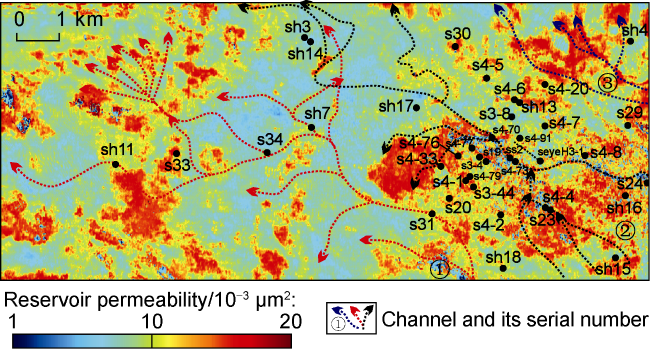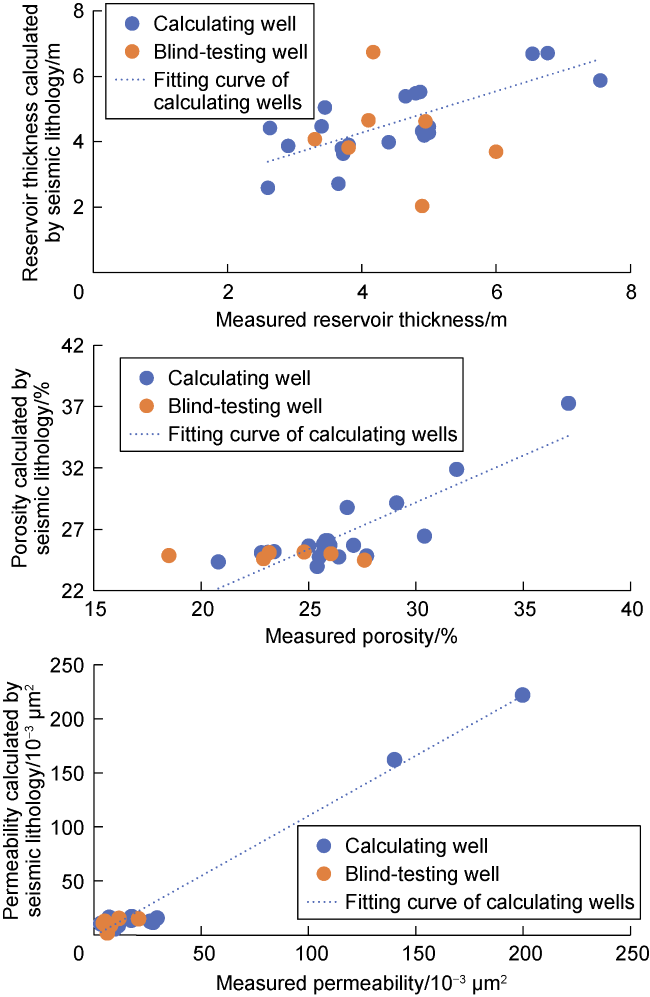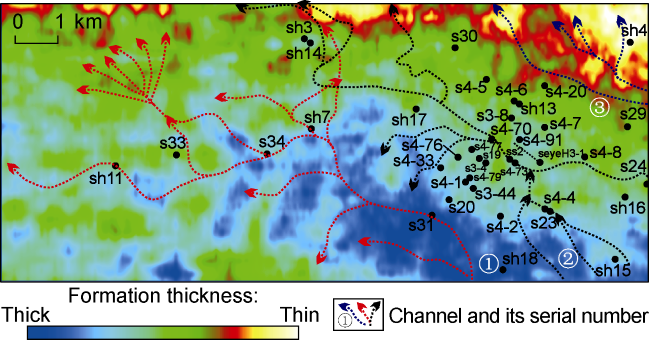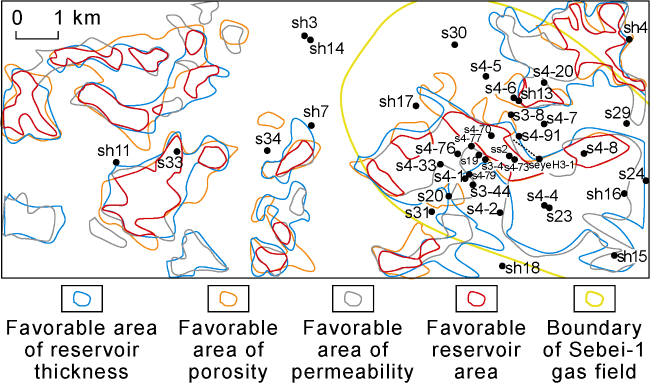Introduction
1. Geological setting
Fig. 2. Stratigraphic column and photos of typical well cores and thin-sections in the Sanhu Depression, Qaidam Basin (modified from Reference [31]). (a) Stratigraphic column and location of the key sandbody (4-1-4cd) in Sanhu Depression; (b) Dark gray laminated silty mudstone, Well st1, 1 282.70 m; (c) Gray striped aragonite silty mudstone, Well st1, 1 309.00 m; (d) Interbed fractures, intergranular pores in debris, and intercrystalline pores in clay minerals, Well st1, 1 282.70 m; (e) Intercrystalline pores in clay minerals, Well st1, 1 309.00 m. |
2. Data and methodology
2.1. Well and seismic data
Table 1. Key reservoir parameters of the key sandbody of K10 in Qigequan Formation in the study area |
| No. | Well | Sandbody thickness/ m | Reservoir thickness/ m | Poro- sity/% | Perme- ability/ 10−3 μm2 | Remarks |
|---|---|---|---|---|---|---|
| 1 | s3-11 | 6.30 | 2.90 | 26.80 | 6.60 | Calculating wells |
| 2 | s3-26 | 5.50 | 3.80 | 25.50 | 7.60 | Calculating wells |
| 3 | s3-3 | 8.64 | 5.00 | 25.90 | 3.30 | Calculating wells |
| 4 | s3-5 | 7.06 | 4.80 | 26.00 | 8.90 | Calculating wells |
| 5 | s3-8 | 6.75 | 3.65 | 27.10 | 11.30 | Calculating wells |
| 6 | s4-1 | 8.34 | 3.40 | 27.70 | 3.30 | Calculating wells |
| 7 | s4-12 | 7.72 | 5.00 | 29.10 | 17.50 | Calculating wells |
| 8 | s4-17 | 8.24 | 4.40 | 22.80 | 7.20 | Calculating wells |
| 9 | s4-2 | 7.10 | 2.63 | 25.40 | 8.00 | Calculating wells |
| 10 | s4-21 | 6.86 | 2.60 | 25.80 | 9.70 | Calculating wells |
| 11 | s4-38 | 6.40 | 3.70 | 26.40 | 8.40 | Calculating wells |
| 12 | ss2 | 7.59 | 6.77 | 30.40 | 17.70 | Calculating wells |
| 13 | s4-6 | 6.66 | 3.45 | 25.70 | 27.60 | Calculating wells |
| 14 | s4-70 | 8.38 | 7.55 | 37.10 | 199.80 | Calculating wells |
| 15 | s4-73 | 6.96 | 6.54 | 31.90 | 140.10 | Calculating wells |
| 16 | s4-77 | 8.17 | 3.72 | 23.40 | 26.20 | Calculating wells |
| 17 | s4-79 | 7.73 | 4.93 | 23.10 | 29.50 | Calculating wells |
| 18 | s4-8 | 9.02 | 4.87 | 20.80 | 9.20 | Calculating wells |
| 19 | s4-9 | 6.06 | 4.90 | 25.00 | 7.20 | Calculating wells |
| 20 | ss3 | 8.44 | 4.65 | 25.70 | 7.39 | Calculating wells |
| 21 | s3-2 | 7.16 | 3.30 | 27.60 | 11.70 | Blind testing wells |
| 22 | s3-6 | 7.40 | 6.00 | 24.80 | 6.20 | Blind testing wells |
| 23 | s3-7 | 7.92 | 4.10 | 26.05 | 7.90 | Blind testing wells |
| 24 | s4-15 | 6.06 | 4.90 | 23.17 | 6.37 | Blind testing wells |
| 25 | s4-33 | 7.49 | 4.17 | 22.90 | 5.10 | Blind testing wells |
| 26 | s4-76 | 7.98 | 3.80 | 18.50 | 20.90 | Blind testing wells |
| 27 | s4-82 | 9.20 | 4.95 | 12.90 | 4.50 | Blind testing wells |
Fig. 3. Seismic profiles of P-wave and S-wave in the study area (see |
2.2. Methodology and workflow
Fig. 4. Research workflow of seismic sedimentology. |
3. Qualitative analysis of sedimentary facies by seismic geomorphology
3.1. Set up the isochronous stratigraphic framework by S-wave seismic data
3.2. Seismic geomorphological characterization
Fig. 5. RGB fused slices of critical periods in Qigequan Formation in the study area (see |
3.3. Lithofacies anatomy of the key target layer
Fig. 6. Typical RGB fused slice of K10 in the study area (a) and the satellite image of the modern Dabsan Lake (b). |
Fig. 7. Well profiles of the key sandbody in the study area (see |
3.4. Interpretation of sedimentary environment for critical intervals
Fig. 8. Sedimentary facies of critical intervals in Qigequan Formation in the study area. |
Table 2. Element and mineral analysis of Well tn18 in K8 in Sanhu Depression, Qaidam Basin |
| Depth/m | Lithology | Ca/Mg | Sr/Ba | SiO2/Al2O3 |
|---|---|---|---|---|
| 1 589.05 | Gray mudstone | 3.37 | 0.29 | 3.78 |
| 1 590.90 | Gray argillaceous siltstone | 1.88 | 0.31 | 3.47 |
| 1 592.50 | Gray mudstone | 3.00 | 0.17 | 3.66 |
| 1 595.73 | Gray mudstone | 1.92 | 0.42 | 3.39 |
| 1 599.30 | Gray mudstone | 2.25 | 0.39 | 3.48 |
| 1 604.13 | Gray mudstone | 0.96 | 0.29 | 3.24 |
4. Quantitative calculation of reservoir properties by seismic lithology
Table 3. Correlation coefficients between seismic attributes and geological parameters of the key sandbody in the study area |
| Seismic attribute | Correlation coefficient | ||
|---|---|---|---|
| Reservoir thickness | Porosity | Permeability | |
| Avg_Energy | 0.339 | 0.348 | 0.017 |
| Avg_SNR | 0.231 | −0.436 | 0.009 |
| Avg_ABS_Amp | 0.354 | 0.360 | 0.027 |
| Avg_Inst_Freq | 0.335 | −0.209 | 0.098 |
| Avg_Inst_Phase | 0.132 | 0.153 | 0.084 |
| Avg_Peak_Amp | 0.138 | 0.035 | −0.272 |
| Avg_Refl_Str | 0.344 | 0.326 | 0.145 |
| Avg_Trough_Amp | 0.435 | 0.079 | 0.375 |
| Corr_Length | −0.383 | −0.023 | −0.372 |
| Energy_Half_Time | 0.210 | −0.064 | 0.211 |
| K-L_Complexity | 0.521 | 0.108 | 0.439 |
| Kurtosis_in_Amp | −0.072 | 0.105 | 0.050 |
| Max_ABS_Amp | 0.313 | 0.351 | 0.053 |
| Max_Peak_Amp | 0.101 | 0.038 | −0.152 |
| Max_Trough_Amp | 0.442 | 0.056 | 0.357 |
| Max_Value | 0.093 | 0.034 | −0.160 |
| Mean_Amplitude | -0.247 | −0.115 | −0.378 |
| Min_Value | -0.402 | −0.062 | −0.299 |
| Num_of_Troughs | 0.379 | 0.322 | 0.454 |
| Number_of_Peaks | 0 | 0.020 | −0.251 |
| Percent_Above | 0.024 | 0.085 | −0.134 |
| Percent_Below | −0.024 | −0.085 | 0.134 |
| PrinComp_P1 | −0.520 | −0.093 | −0.424 |
| PrinComp_P2 | 0.521 | 0.108 | 0.439 |
| PrinComp_P3 | −0.458 | −0.093 | 0.037 |
| RMS_Amplitude | 0.339 | 0.348 | 0.017 |
| Skew_in_Amp | 0.162 | 0.172 | 0.410 |
| Slope_Half_Time | 0.158 | 0.308 | −0.066 |
| Slope_Inst_Freq | −0.299 | −0.357 | −0.294 |
| Slope_Refl_Str | −0.351 | −0.318 | −0.196 |
| Thickness_of_Amp | −0.258 | −0.179 | −0.350 |
| Total_ABS_Amp | 0.354 | 0.360 | 0.027 |
| Total_Amplitude | −0.247 | −0.115 | −0.378 |
| Total_Energy | 0.339 | 0.348 | 0.017 |
| Variance_in_Amp | 0.411 | 0.163 | 0.102 |
4.1. Reservoir thickness
Table 4. PCA results of reservoir thickness of the key sandbody in the study area |
| Principal component | Information proportion/% | Eigen value | Attribute with max. contribution (weight) |
|---|---|---|---|
| PCA1 | 55.638 31 | 0.057 36 | Corr_Length |
| PCA2 | 27.506 82 | 0.028 36 | Corr_Length |
| PCA3 | 6.667 81 | 0.006 87 | Num_of_Troughs |
| PCA4 | 3.880 87 | 0.004 00 | Variance_in_Amp |
| PCA5 | 3.264 24 | 0.003 37 | Min_Value |
| PCA6 | 2.073 91 | 0.002 14 | PrinComp_P2 |
| PCA7 | 0.498 37 | 0.000 51 | PrinComp_P1 |
| PCA8 | 0.295 54 | 0.000 03 | Avg_Trough_Amp |
| PCA9 | 0.135 41 | 0.000 14 | PrinComp_P3 |
| PCA10 | 0.038 71 | 0.000 04 | K-L_Complexity |
Fig. 9. Overlay of reservoir thickness and channels of the key sandbody in the study area. |
4.2. Reservoir porosity
Fig. 10. Overlay of reservoir porosity and channels of the key sandbody in the study area. |
4.3. Reservoir permeability
Fig. 11. Overlay of reservoir permeability and channels of the key sandbody in the study area. |
4.4. Calculation results verification
Fig. 12. Verification of reservoir thickness, porosity and permeability results of the key sandbody in the study area. |
5. Facies-controlled reservoir features and prediction of favorable areas
5.1. Controlling effect of facies on the reservoir
Fig. 13. Overlay of landform and channels of the key sandbody in the study area. |
5.2. Prediction of favorable areas
Fig. 14. Favorable reservoir area of the key sandbody in the study area. |















